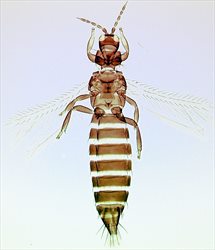
Female (dark form)
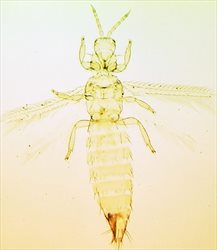
Female (pale form)

Antenna
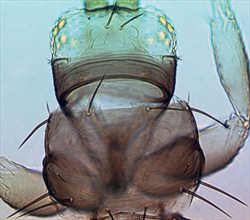
Head & pronotum
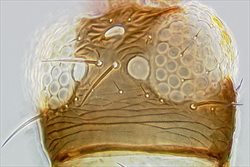
Head
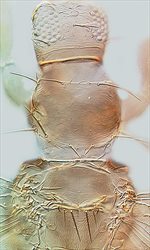
Head & thoracic tergites
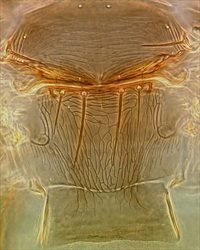
Meso & metanota
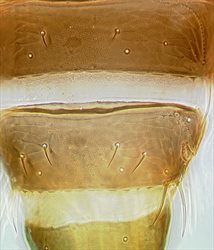
Tergites VII-IX
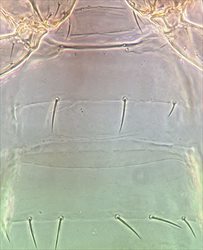
Female sternites I-III

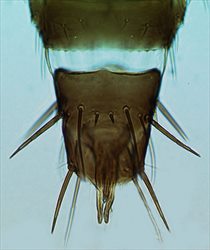
Male tergite IX
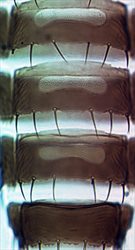
Male sternites IV-VII
Both sexes fully winged. Body either brown with pronotum tibiae and tarsi paler, or body yellow with faint shadings on tergites; antennal segments III–V yellow at least at base; fore wing pale with dark setae. Antennae 8-segmented; segments III–IV each with forked sense cone, segment VIII longer than VII. Head wider than long; three pairs of ocellar setae present, pair III arising close together between hind ocelli, as long as side of ocellar triangle; postocular setae pair IV as long as distance between hind ocelli. Pronotum with 5 pairs of major setae; anteromarginal setae slightly shorter than anteroangulars, one pair of minor setae present medially between posteromarginal submedian setae; upper surface of fore coxae with microtrichia on sculpture lines. Metanotum with 2 pairs of setae at anterior margin, campaniform sensilla absent. Fore wing with 2 complete rows of veinal setae. Abdominal tergites VI–VIII with paired ctenidia, on VIII anterolateral to spiracle; posteromarginal comb on VIII not developed or represented by few weak lobes. Sternites III–VII without discal setae.
Male yellow, smaller than female; tergite VIII with a few teeth laterally on posterior margin; sternites III–VII each with broadly transverse pore plate.
The origin and relationships of F. schultzei remain unclear. It does not seem to be closely related to any other member of the genus. It is generally considered to be from South America, but it is possibly from Africa. Currently 230 species are listed in Frankliniella, with up to 130 further names placed into synonymy (Nakahara, 1997). These synonymies result from unrecognized variability in size and colour exhibited by many species. This variation is reflected in the large number of subspecies names listed under schultzei. However, there are further problems with this species. Variation has been detected between populations in molecular data (Hereward et al., 2017), although the biological significance of these differences remains unclear. Currently there is no evidence of a difference in biology between forms that are yellow or brown, although the name sulphurea is available for forms that are yellow. However, there is no evidence that yellow individuals are genetically identical at all localities, and colour differences are widespread around the world. A claim that the "yellow form" is not a tospovirus vector was based on a single population from Egypt, but the main tospovirus vector on vegetable crops in northeastern Australia is a bisexual yellow form.
Feeding and breeding in flowers and on the leaves of a very wide range of plants; however, more than one genetic entity may remain to be distinguished within this species.
The Tomato Thrips is widespread in tropical and subtropical countries. A single adult female was found outdoors in Berkshire in 1914 (Bagnall, 1926; Collins, 2006). Otherwise, the species is known only in association with plant imports and is regularly intercepted at airports by the Plant Health Service of England and Wales; a single female found on a sticky trap at a commercial nursery is likely to have flown in from a neighbouring building where imported cut flowers were being processed (Collins, 2010a). The species is not thought to be currently present in Britain, though it is established in cactus production greenhouses in the Netherlands (Vierbergen & Mantel, 1991).
THRIPIDAE - THRIPINAE
Frankliniella schultzei (Trybom)
Physopus schultzei Trybom, 1910: 151
Euthrips gossypii Shiraki, 1912: 65
Frankliniella sulphurea Schmutz, 1913: 1019
Frankliniella delicatula Bagnall, 1919: 263
Frankliniella trybomi Karny, 1920: 36
Frankliniella persetosa Karny, 1922: 97
Frankliniella dampfi Priesner, 1923: 64
Frankliniella tabacicola Karny, 1925: 4
Frankliniella dampfi interocellaris Karny, 1925: 126
Frankliniella anglicana Bagnall, 1926: 281
Frankliniella africana Bagnall, 1926: 100
Frankliniella aeschyli Girault, 1927: 2
Parafrankliniella nigripes Girault, 1928: 4
Frankliniella paucispinosa Moulton, 1933: 128
Frankliniella kellyana Kelly & Mayne, 1934: 20
Frankliniella dampfi f. nana Priesner, 1936: 85
Frankliniella lycopersici Andrewartha, 1937: 163
Frankliniella favoniana Priesner, 1938: 30
Frankliniella pembertoni Moulton, 1940: 247
Frankliniella clitoriae Moulton, 1940: 248
Frankliniella ipomoeae Moulton, 1948: 95
Frankliniella schultzei f. nigra Moulton, 1948: 100
Bagnall RS (1926) On some new British Thysanoptera. Entomologist’s Monthly Magazine 62: 279–285.
Collins DW (2006) Odontothrips confusus Priesner (Thysanoptera: Thripidae) new to Britain and recent records of other British thrips. British Journal of Entomology and Natural History 19: 145–156.
Collins DW (2010a) Thysanoptera of Great Britain: a revised and updated checklist. Zootaxa 2412: 21–41.
Hereward J, Hutchinson JA, McCulloch GA, Silva R & Walter GH (2017) Divergence among generalist herbivores: the Frankliniella schultzei species complex in Australia (Thysanoptera: Thripidae). Arthropod-Plant Interactions 11 (6): 875–887. DOI 10.1007/s1 1829-017-9543-3.
Nakahara S (1997) Annotated list of the Frankliniella species of the world (Thysanoptera: Thripidae). Contributions on Entomology, International 2 (4): 355–389.
Vierbergen G & Mantel WP (1991) Contribution to the knowledge of Frankliniella schultzei (Thysanoptera: Thripidae). Entomologische berichten 51: 7–12.